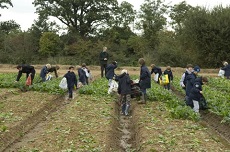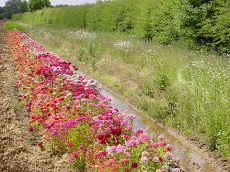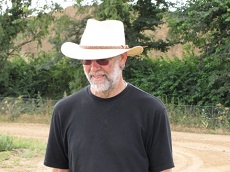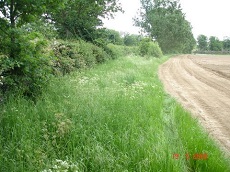From Gravel To Fennel At Laleham Farm
Brett Aggregates hosted an educational restoration event at the company’s Laleham Farm site near Staines recently
Brett Aggregates hosted an educational restoration event at the company’s Laleham Farm site near Staines recently, offering delegates the opportunity to see how farmland can be successfully restored after quarrying operations.
The event was run by Nature after Minerals (NAM) - a partnership between Natural England and the RSPB, in conjunction with Interreg IVB North West Europe which part funds NAM under the RESTORE project.
The theme of the event was Biodiversity enhancements within agricultural restorations and the day began with presentations by representatives of NAM and the RSPB, followed by a talk on the history of the Laleham Farm site by Brett Aggregates Land Manager, Henry Carter. The group then travelled to Laleham Farm for a tour led by Henry and tenant farmer, Charlie Bransden. Attendees included planners, ecologists and landscape architects representing county councils, environmental organisations and other aggregate companies.
The aim of the event was to show that even though a quarry may be returned to agricultural use, there are still many features which can be incorporated into a restoration plan to enhance the biodiversity value of a site. In visiting Laleham Farm, a former sand and gravel quarry mined by Brett Aggregates, the delegates were able to see first-hand how the land has been restored to fertile, highly productive farmland, whilst catering for the needs of wildlife and the natural environment.
“It was a great privilege to host this event,” said Henry. “Brett Aggregates is very proud of what has been achieved at Laleham Farm, working closely with our tenant farmer and balancing the company’s interests with consideration for the environment.
The 45-hectare site was mined for 20 years and progressively restored to immaculate farmland – a scheme that won Brett Aggregates the Mineral Product Association’s “Best of the Best” award in 2009 which looked at award-winning restoration projects over a 40 year period. Key to the successful restoration was the careful handling and replacement of alluvial topsoil and subsoil across the site, which retained the farm’s fertility, allowing tenant farmers B.E.Bransden and Sons to grow a variety of herbs, vegetables and flowers which are sold to specialist markets, local farm shops and greengrocers and restaurants in and around London.
Charlie Bransden and his sister Clare took over the farm from their parents in 1992, having worked alongside them in the business for a number of years. They head up the team of 18 staff, including a multi-national harvesting team of 12 and four technicians. The crops produced at the farm require intensive care, regular sowings and harvesting to keep a steady flow of produce to meet demand and the methods used enable the Bransdens to grow 75 hectares’ worth of crops on around 40 hectares of ground – a true “Market Garden”.
The numbers are impressive: spinach is grown with 60 separate sowings each year producing 100,000 boxes of 12 bunches each; there are 30 sowings of giant spring onions, producing 60,000 boxes containing 12 bunches each year; 40 sowings of coriander produce 28,000 boxes each containing 12 bunches and so it goes on with multiple sowings of flat leaf parsley, dill, fennel, kohlrabi, black cabbage and sweetcorn. Each product has a limited window for harvesting in order to catch it at its best and every item is picked by hand, fresh on-demand, chilled and despatched on the same day. The team also grows and harvests Sweet Williams, wallflowers and sunflowers. In all the farm produces around three million hand-harvested bunches of product each year.
“The irrigations systems on the farm are important as they allow us to apply exactly the right amount of water to precisely the right place,” says Managing Director, Charlie. “A combination of booms, solid-set sprinklers and trickle enables us to produce high quality and high yields, and yet be economical, as we have sufficient application capacity to apply little and often, or more if necessary without run-off or exceeding the soil moisture capacity. This is all micro-managed with constant monitoring by our dedicated irrigation specialist,” he explains.
But it is not just the crops that thrive at Laleham Farm. It is a haven for wildlife, especially birds, with nesting sand martins, plovers, lapwings and kingfishers among the long list of residents on the site. Care has been taken to follow L.E.A.F. (Linking Environment and Farming) principles as the farm has developed with over two kilometres of new hedgerows planted in the last 20 years and careful maintenance of perimeter hedging to provide wildlife corridors, nesting sites and shelter for everything from small mammals to birds and insects. The farm now has over 3000 square metres of wildlife-friendly margins, often buzzing with the many species of bee that are attracted by the pollenating wild flowers growing there.
The ever-present water on the farm is a great attraction for wildlife too. “We see scores of sand martins swooping down to the silty mud by the irrigator reel to line their nests and finches galore as well as plovers and lapwings who stalk the booms as they travel up the field,” says Charlie.
Laleham Farm has been an L.E.A.F demonstration farm for over 15 years, hosting regular tours for L.E.A.F. groups and Charlie often gives talks and slideshows to local interest groups. Charlie and Clare have always welcomed school groups and in recent years have becoming involved with F.A.C.E. (Farming and Countryside Education) whose aim is to educate children and young people about food and farming in a sustainable countryside.
“We now have the pleasure of hosting inner-city primary school groups, as well as our regulars,” says Charlie. “It does mean that May, June & July are seven days a week for me, to manage my workload as well as take visitors and schools around. We are now almost “full-up” during the season. Exhausting but fun.”







